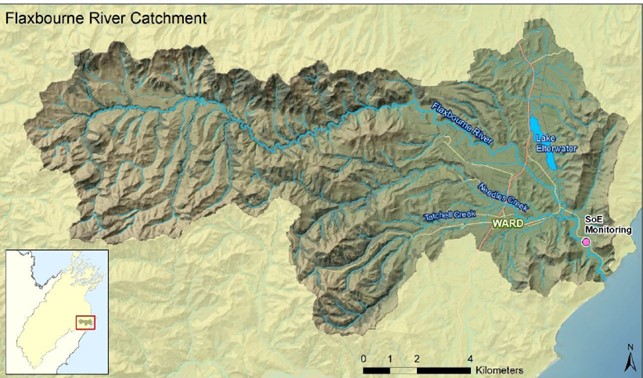Council’s Blenheim office will be closed from 4.30 pm Thursday 17 April and will reopen on Tuesday 22 April at 8.30 am. See details of transfer station opening hours and kerbside collections

Council’s Blenheim office will be closed from 4.30 pm Thursday 17 April and will reopen on Tuesday 22 April at 8.30 am. See details of transfer station opening hours and kerbside collections


The Flaxbourne catchment is in the South-East of the Marlborough region. It receives comparatively little rainfall causing river flows to be low. During dry summers, parts of the river and its tributary streams run dry with flow only continuing within the river gravels.
Very little native vegetation remains in the catchment. More than 80% of the catchment area has been converted to pasture, grazed by sheep and beef cattle. In the lower parts of the catchment, small areas of vineyard and cropping are also present.
The Flaxbourne River has been monitored as part of the State of the Environment programme since 2007. This monitoring has shown that river health is degraded.
Parts of the Flaxbourne catchment flow into a shallow coastal lake, Lake Elterwater. Although the lake has an outlet that flows into the Flaxbourne River, the outlet very rarely contains flowing water. Lake Elterwater is rarely more than one metre deep and has dried up completely in the past. The monitoring results show that the health of the lake is severely impacted, with several parameters below the national bottom line of the NPS-FM. These include Total Nitrogen and Total Phosphorus concentrations as well as concentrations of Chlorophyll-a.
A Catchment Care programme has already been initiated for the Flaxbourne. Two catchment groups, one for the wider catchment and another specifically for Lake Elterwater, are meeting on a regular basis to discuss ways to improve water quality. Restoration action has already started, including the removal of willows and planting of native vegetation around Lake Elterwater.
Overall trend analysis for the Flaxbourne River shows comparatively little change in water quality, apart from an increase in E.coli levels.